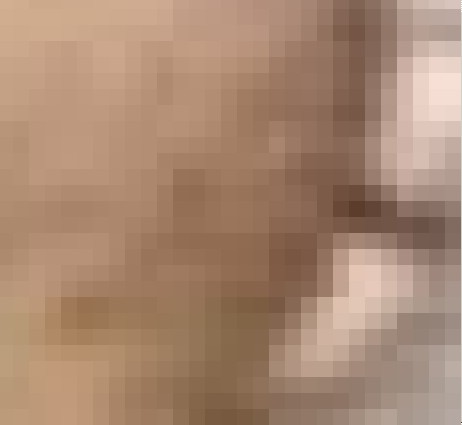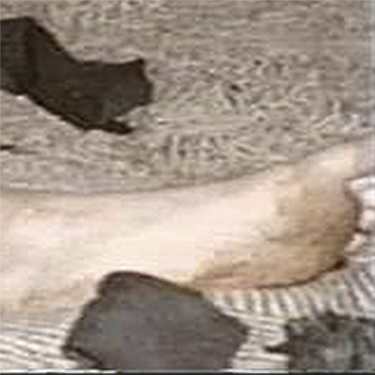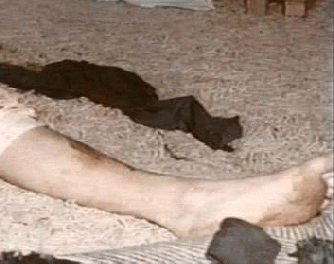|
For researchers of the murders of Colette, Kimberley and Kristen MacDonald
Debunking FrmrCSI’s alleged “analysis” of the bloody footprints
|
|
February 2007
Recently, a poster on the Crime and Justice/Jeffrey MacDonald discussion board claimed, in the “Bloody Footprint” thread, to have supposedly “analyzed” the crime scene photos of Jeffrey MacDonald's footprints in the hallway of 544 Castle Drive and the photo of Colette's foot. Despite the fact that the print in the hallway was too big to be Colette’s and that MacDonald had admitted the print was probably his (which it later proved to be), the poster came to the surprising conclusion that there was an “80%” possibility that a bloody footprint in the hallway was Colette’s.
In answer to this, another poster pointed out that not only were the crime scene pictures no doubt many-generation (degraded) by the time they were first posted online, but the processes FrmrCSI peformed would have degraded the images even more. That poster also provided a link to an image which illustrated that even greatly magnifying a portion of the JPEG image showing the ball of Colette’s foot provides no usable detail with regard to “ridge lines” or other such things, primarily because the original crime scene images which had been posted online were created as low-resolution JPEG images, rendering them useless for analyzation of the type FrmrCSI claims to have done.
|
|
No ridge lines are visible in the JPEG crime scene photo even at
high magnification (ball portion of Colette’s foot shown below):
|
 |
 |
|
Apparently not realizing that the point of showing the image above was not to "see the foot," since in the crime scene photo we can see the foot already without any problem, and that the point was to zoom in to see the detail (or lack thereof) in the image he used in his alleged analysis, FrmrCSI responded to this by claiming that "If you would not have enlarged your picture you would be able to see the foot, if that is what it is. Th emore you enlarge the picture the more the picture will pixelate. While I did enlagre them a little, and provides a more focus, it also made the file larger. I did not lose any clarity in the picture....JMHO" [spelling and punctuation preserved]
So it appears that FrmrCSI is claiming that the cropped image above should not have been enlarged, but his own version (shown below) was enlarged in order to perform his alleged analysis. Interesting.
The truth is that enlarging any scan via some zoom tool will indeed show the pixels that make up the image. However, enlarging a scan via the use of a computer’s resizing function, or scanning a printout of a low-resolution JPEG image in a high resolution as FrmrCSI claims to have done, results in the computer “faking it” and using software and/or scanner interpolation and algorithms to put information in the picture that was not there originally.
Click here to see a collection of images showing the results of magnification, interpolation and anti-aliasing on one of the pictures FrmrCSI claims to have “enhanced” and used for his alleged “high-end” analysis, as well as samples showing magnification of the original low-resolution JPEG crime scene photo.
FrmrCSI also posted links to the three pictures he used in his alleged analysis, which included one full-sized copy of a photo from the collection of online crime photos, and two images cropped from the same collection, one of which he said he had “enhanced” and enlarged in preparation for his analysis software:
|
 |
 |
|
But wait. Something seems wrong here. Doesn’t the image above look a bit…stretched, as well as degraded in quality? Let’s compare the same cropped area in the original crime scene photo (left, below) to FrmrCSI’s “enhanced” and “enlarged” image of Colette’s foot.
When the images are side by side, we can see that FrmrCSI did not know how to size his image correctly, resulting in his image having lost its aspect ratio (correct width for the height of the image). Not only does a degradation of quality exist in FrmrCSI’s image, but an obvious difference in width is also apparent:
|
|
Let’s do another test to be sure. What happens when FrmrCSI’s image is put into place on the original crime scene photo? As can be seen below, it becomes obvious that the aspect ratio has been lost. Note how in the crime scene photo (below left), Colette’s toes are visible, but when FrmrCSI’s image is overlaid on top, the toes disappear, running off the edge of the photo, because the aspect ratio is incorrect and the foot has been made quite a bit longer than it actually is:
|
 |
 |
|
|
Cropped section of original crime scene photo
|
|
|
|
This alone, of course, is more than enough to negate any “analysis” FrmrCSI claims to have done. But wait, there’s more.
In order to perform his alleged analysis, FrmrCSI claims that he first copied the low-resolution JPEGs from the internet, saved them, "enhanced" them, then "printout as a transparency...on a highend photo printer, then scan into another computer on a highend scanner, (both printer and scanner is more than your normal citizen can afford). Then you manipulate the photos so that one is on top of another. Or you copy the images onto a thumb drive and transfer them that way. Either way you will not lose the digital quality that was mentioned earlier. JMHO" [spelling and punctuation preserved]
The crime scene pictures originally posted online are JPEG images. JPEG compression is a "lossy" data compression method, meaning it results in loss of pixel information. Therefore, the “quality” to which FrmrCSI refers is not there to begin with in the compressed images online, and no enhancement or conversion by any scanner or software--high-end or otherwise--can put the original pixel information needed for analysis back into the JPEG image once it's been removed. Additionally, the JPEG algorithm “pixellates,” for lack of a better word, creating spotty areas and other degradation due to the loss of pixel data (depending on the amount of compression used, this degradation may or may not be noticeable when the image is being viewed normally). These “spotty” effects and other degradation would not be in the raw, high-resolution scan from which the JPEG was made, so, from that aspect, one can say that the JPEG format is, interestingly, both a lossy format and one that adds unwanted data to an image that was not in the original high-resolution scan. (Even disregarding everything else, that fact alone would make the original online JPEGs completely unsuitable for any kind of serious computer analyzation of the type FrmrCSI claims to have done.)
Moreover, most of the crime scene images originally posted online were only 626 pixels wide, with an average size of 35K or so, meaning that even more data that had been in the original high-resolution scan was removed when that resizing was done. (And selecting even a relatively large portion of the ball of Colette's foot in the original crime scene JPEG photo results in an image only 45 or so pixels wide, even less suitable for computer analyzation of this kind, in fact ridiculously unsuitable.)
Click here to see how the JPEG algorithm results in degradation and loss of pixel data, and to see why this is one primary reason why JPEG images would never be used in any sort of high-end analysis of the type FrmrCSI claims to have done.
In sum, after examination of FrmrCSI’s images, and his comments about how he performed his alleged analysis, we find that this analysis seems to have consisted of the following:
(1) Copying low-resolution, low-quality JPEG images from the internet, images which had already lost enormous amounts of unrecoverable original pixel data;
(2) “Enhancing” one of the images (which apparently consisted only of changing the contrast and color balance);
(3) Wrongly sizing that image, adding unwanted data and also resulting in Colette's foot being much bigger than it actually is;
(4) Supposedly making a "transparency" from that image, giving him the same low-quality image on clear “paper”;
(5) Supposedly scanning the low-quality transparency at a high resolution, giving him a high-resolution interpolated image of a transparency made from a low-quality scan (but he contradicts himself by claiming he only enlarged “a little”);
(6) Supposedly making another transparency from the low-resolution JPEG image of the footprint(s) in the hallway;
(7) Scanning that transparency (again adding unwanted data to the image via interpolation);
(8) Supposedly overlaying this low-quality image on top of his prior low-quality and wrongly-sized image, and
(9) Supposedly having “analysis software” analyze this final overlay image.
The truth is that overlaying the image of Colette's foot on top of the photo of the print of the hallway in the way FrmrCSI claims to have done would produce nothing more than a new image that, like the original JPEGs, does not contain anywhere near the amount of pixel information that would be needed for the kind of analyzation he's claiming to have done. In fact, it would be worse than the image(s) he started with, because of the loss of aspect ratio in Colette’s foot, and because of the degradation, interpolation and anti-aliasing (resulting in “smoothing” of pixels) that occurred when he did his image processing.
Regarding FrmrCSI’s comment about thumb drives, thumb drives would have little or no bearing at all on such computer analyzation, since they have no more ability to recover original lost information in an image than any other device.
Finally, it should be noted that as of this writing, FrmrCSI has produced none of the supposed photo “transparencies” he claims to have made, nor did he provide any detailed information regarding the type of printer, scanner and software used in his analysis. Even more surprisingly, he failed to provide any final report of the figures his alleged analysis software would have presumably output at the end of the analysis. Perhaps most tellingly of all, however, when his analysis had been completed, despite his claim that the results of the analysis showed that there was an “80%” possibility that a bloody footprint in the hallway was Colette’s and not MacDonald’s, and claiming that “If you would like to see the picture I have after doing what I stated tell me how to upload it. I will be more than happy to post it straight from my computer,” FrmrCSI refused to provide any link to the final “overlay” image he claimed to have created.
|
|
|